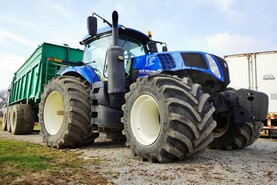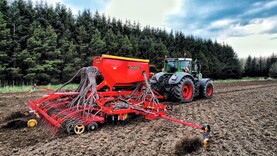Grazing and silage swards that were damaged by livestock and machinery last summer and autumn will need repairing this year, otherwise grass growth may be significantly reduced.
But before you rush on to grassland with either the roller, or the plough, you should consider all possible options for repairing and reseeding swards.
In certain cases, where swards have merely suffered mild surface damage from poaching, paddocks can be repaired through good grazing management of livestock. In other cases, where poaching is more severe, or silage and slurry equipment have caused lasting damage to swards, minimum tillage methods may be an alternative to conventional reseeding.
Regardless of the strategy used, the outcome will be greatly enhanced by addressing the issue of soil fertility.
Applying lime and compound NPK fertilisers will help swards to recover from poaching, as well as encouraging plants to tiller, and aid the repair of root systems.
While prolonged spells of wet weather this spring have delayed many farmers from repairing grassland, if you are planning on carrying out fieldwork in the next few weeks, consider the following options for sward reparation and rejuvenation.
How to repair damaged swards on your farm
1 Allow grazing cattle to level land: where paddocks have surface damage caused by poaching, more often than not, it can be levelled out again by grazing livestock. This option works best where poaching is confined to the top five to six inches of soil.
It is still important to manage swards carefully during this period. Therefore, rotationally grazing cattle works best.
Cattle should be grazed in paddocks for two to four days before moving them to the next paddock in the rotation.
This allows swards time to rest and recover. It also prevents further poaching occurring once swards have been grazed bare.
2 Use a grass or chain harrow: if poaching is more severe, using a grass or chain harrow can level out ground again and should be considered as a more effective option than rolling.
Using a harrow will also remove dead grass and shallow rooted weeds that have become established after a sward has been damaged and become open at the base.
These weeds, or less productive grasses, will compete for soil nutrients and therefore reduce overall grass growth.
3 Rolling: when swards have become poached or damaged from machinery, the most obvious method of repairing grassland is using a roller.
However, while it will level out a field, it can do long-term damage from compressing and compacting soils.
A roller should only be used in the correct conditions.
If you roll swards when ground conditions are still soft, the top few inches of the soil can easily become compacted. This makes it difficult for plant roots to penetrate downwards and access soil nutrients.
It also makes it harder for rain water to drain properly, causing soils to hold water during and after periods of wet weather. Wet soils have lower temperatures, which again limit grass growth.
Most research indicates that compaction caused by rolling ground can limit grass growth by 10% to 20%.
Therefore, if you do decide to roll land, use a light roller to minimise compaction, and wait until later in the year when grass growth is sufficient to meet livestock demand.
4 Sub-soiling: where swards have been damaged, they will benefit from sub-soiling, especially if they have been rolled.
Soil conditions must be dry to be most effective as dry ground will shatter and open more. This will help to alleviate compaction, aerate soils and improve drainage. Using a sub-soiler in less than ideal conditions could make the problem worse.
5 Fertiliser: applying compound NPK fertilisers will improve sward recovery. On lighter soils, there is also likely to be a benefit from using fertiliser with added sulphur.
Where soil is below a pH of 6.0, spreading lime will improve nutrient uptake, increase grass growth, and will also help to condition soil, improving natural drainage.
Before reseeding, soils should be limed to correct a low pH. Liming will also improve germination, especially where an older sward has been burned off in advance.
Dead grass is acidic and that can inhibit the germination of grass seed. Compound fertilisers will also help swards to establish faster, as well as tiller out.
There are three main options to consider if a decision is made to reseed a sward:
Broadcast grass seed
Where swards have become open from grazing, you can rejuvenate them by simply broadcasting grass seed using a fertiliser spreader.
You should sow grass seed at a rate of 12kg to 14kg per acre.
For best results, broadcast half the seed by driving up and down the field with the remainder spread by driving across the field.
With this option, it is important that swards are repeatedly grazed tight during each rotation, and that cattle are limited to no more than three to four days in a paddock before moving to fresh grass.
This reduces heavy grass covers from smothering seedling plants, prevents seedling plants from being overgrazed, and allows sunlight to get to the base of the sward to stimulate growth.
Stitch-in grass
For established swards which are less open, but still require rejuvenation, stitching in grass will be more effective than simply broadcasting seed. Using a machine such as an Einbock seeder, which can harrow ground while sowing grass seed, will also help to level out the sward.
The benefit of stitching-in grass compared with ploughing is that cattle can continue grazing on existing swards, reducing the pressure on grazing land during periods of lower grass growth.
Stitching-in grass also maintains a firmer seed bed, meaning that swards can be grazed by cattle much sooner after sowing compared to a ploughed reseed.
Sub-soiling later in summer may also help improve drainage and aeration.
Conventional ploughing
If swards have been heavily damaged and are retaining water, then ploughing will be the best option to remedy the situation, but it will also be the most expensive.
Before ploughing, any land drainage work that is required should be completed. While ploughing will improve soil drainage, it will not correct problems caused by natural springs or low-lying areas in fields where water tends to accumulate.
Ploughing should be undertaken during a period when grazing ground is not under pressure, as a newly established sward will not be suited to carrying livestock for six to eight weeks, especially if conditions turn unfavourable.
BETTER farm: reseeding benefits laid bare in Thurles
Advice on maximising the return on your reseeding investment






 This is a subscriber-only article
This is a subscriber-only article











SHARING OPTIONS: